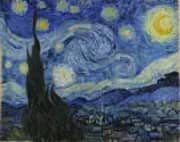Starry Night 1889 By Vincent van Gogh
Starry Night is Vincent van Gogh’s most famous painting. For art critics and historians, it is his career-defining masterpiece in oil painting. Alongside works such as Leonardo Da Vinci’s Mona Lisa and Claude Monet’s Water Lilies paintings, it is one of the most recognized paintings of Western European art.
When was The Starry Night painted?
To answer the question, “When was Starry Night painted?” Vincent's letters are invaluable. For example, in June 1889, Van Gogh wrote a letter to his brother Theo describing a new study of a starry sky he was currently painting.
The previous month, he had told of the wheat fields visible from his bedroom window. In July, Van Gogh also described how the massive morning star lit up the countryside. The original Starry Night painting reliably dates to the spring and summer of 1889.
Although Vincent Van Gogh painted the same view in many different forms, his Starry Night painting is the only nocturne among these works. Excitingly, astronomers confirm that Venus, known as the morning star, was visible in Provence during the spring and summer of 1889. It was indeed incredibly bright during this period, which means that the star in the painting, to the right of the cypress tree, is the planet Venus.
Where did Vincent van Gogh paint The Starry Night?
In addition to the date of the painting, many people also ask where Van Gogh painted Starry Night.
Van Gogh painted The Starry Night in 1889 in Saint-Rémy-de-Provence. It is a small yet idyllic commune in the Bouches-du-Rhône department, located in the Côte d'Azur region of Southern France. Starry Night was started after days spent gazing out from his east-facing lunatic asylum room window.
Consequently, much of the view was imaginary. Elements not apparent in the real scene included the dream-like village and the proximity of the cypress trees. The painting also depicts the moon as waning gibbous, as opposed to the waning crescent, which was indeed its phase during this time.
During this period, he convalesced in the Saint-Paul de Mausole asylum after his 1888 mental breakdown. The culminating episode of this breakdown resulted in Van Gogh cutting off his ear, famously depicted in Self-Portrait with Bandaged Ear (1889). After this collapse, he voluntarily committed himself to the Asylum for treatment.
Alongside Starry Night, Vincent Van Gogh painted many of the best-known works of his career during his time in Saint-Rémy-de-Provence. He also created beautifully haunting works, such as "Irises 1889 and the Blue Self-Portrait, while at the asylum.
What art movement are van Gogh's paintings?
Van Gogh’s "Starry Night over the Rhone" inspired the post-impressionist art movement. Originating in the carnage of the First World War, post-expressionist artists sought to convey the soul or spirit of people and places through expressive brushstrokes. This technique contrasts with the introverted characteristics of expressionism, which prizes the artist’s internal psychic reality above all else.
Vincent Van Gogh himself was a member of the post-impressionist art movement. This movement was a reaction that started in the 1880s against impressionism, led by Claude Monet.
Colorful Wall Art paintings
Van Gogh’s Starry Night exemplifies this approach. The swirling brushstrokes and luminescent tones strongly represent the artist's inner turmoil and emotional response to the world outside his window. As a true modern masterpiece, the painting has been on permanent display in the Museum of Modern Art since its bequest in 1941.
Van Gogh reproductions are among our most popular reproductions of famous paintings.
Explore van Gogh's Starry Night painting for sale and other colorful wall art in our online catalog.
We offer a 100% money back guarantee or replacement service. If for any reason you are dissatisfied with your painting please contact us within 7 days of receipt, advising the reason you are unhappy and we will provide you with all the information you need for its return or replacement.
We ship free to anywhere in the world via FedEx or DHL expedited service with online tracking.
Your painting will be shipped rolled in strong plastic tubing, ready for stretching and/or framing locally. This is the conventional method of transporting hand-painted oil on canvas. Learn more about how your painting is shipped.
We are able to offer a framing service intercontinental U.S. Please contact us if you would like a quotation. Alternatively, should you prefer, we can recommend a framer in your area.
Your painting will be shipped directly from our Studio in Thailand.
Notes About Your Painting
All of our paintings come with a 7.5cm (just under 3") clean surplus canvas so the framer can achieve good leverage and easy stretching.
Recently Viewed:
Cannot Find What You Are Looking For?
Reproduction Gallery Information
Customer Service
(Send Us A Message)
Tel: (302) 513 3464






